Those who have tried the remarkable performance gains they can achieve with an SSD can’t get enough. Hence, people often ask how to add more M.2 SSD slots or a second SSD if their motherboard only has a single M.2 slot.
Fortunately, adding more M.2 slots to your SSD is pretty simple. It will require a small investment, though. You need to purchase an M. 2-slot PCIe expansion card.
These PCIe expansion cards can feature 1-4 M.2 slots for NVMe SSDs.
However, before you make the purchase, you must understand how to purchase the right M.2 expansion card, where you would plug it in, and also learn about PCIe lanes and how they matter for M.2 slots.
TABLE OF CONTENTS
A Brief on PCIe Lanes, Slots, and M.2 Slots
So as alluded to earlier, to add more M.2 slots to your motherboard, you will need to purchase an M.2 PCIe expansion card. These cards require a free PCIe slot on your motherboard and occupy PCIe lanes. But first check for how many M.2 Slots do motherboards have.
It is ok if all this sounds too confusing to you. I will break this down for you here.
What are PCIe Slots?
PCIe slots add expansion cards to your PC, including graphics cards, WiFi cards, M.2 expansion cards, etc.
These are pretty hard to miss, as all motherboards have them.
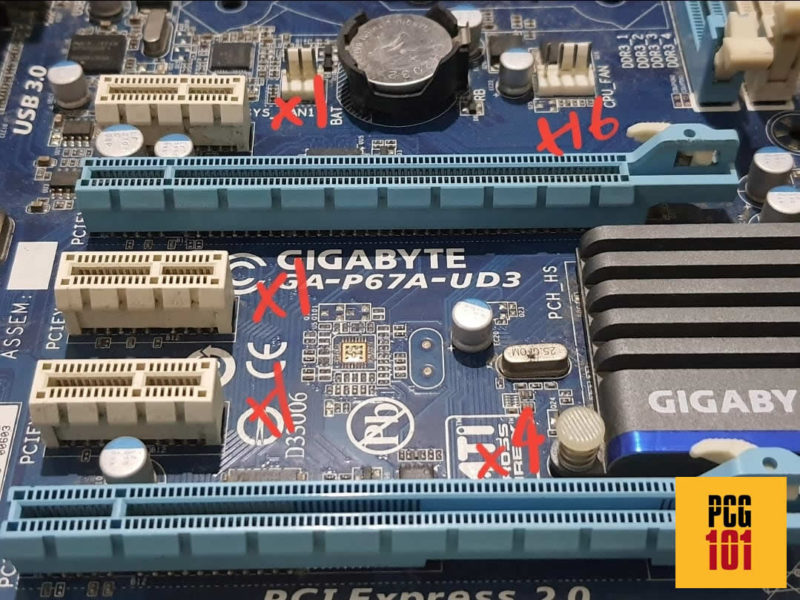
Now there are different sizes of PCIe slots. All of these slots connect to PCIe lanes.
For instance, the x1 slot is the most undersized PCIe slot. This slot connects to only a SINGLE PCIe lane. Hence it is intended for smaller and low-demanding expansion cards.
An x16 slot is the largest PCIe slot and ideally connects to 16 PCIe lanes. However, in many cases, you can find a PCIe x16 slot with a physical size of a full x16 slot, but in reality, it would only be connected to four PCIe lanes – as you can see in the image above, the bottom PCIe slot only connects to FOUR PCIe lanes.
You should check your motherboard’s spec sheet to figure out the specs of each PCIe slot on your motherboard.
Also Read: Can You Put M.2 SSD in PCIe Slot?
What are PCIe Lanes?
PCIe lanes are information highways sending information to and from the device and the CPU/motherboard.
A limited number of PCIe lanes are available to your PC, and the total amount of PCIe lanes is determined by the CPU and the motherboard you have.
Also Read:
How Many PCIe Lanes Does an M.2 Slot Use?
Now, this part is significant to understand.
An NVMe SSD operates on the PCIe interface. Hence, NVMe SSDs are also called PCIe SSDs.
A typical NVMe SSD requires 4 PCIe lanes to work. Let me reiterate this point:
A PCIe NVMe SSD requires 4 PCIe lanes to work at optimal capacity.
This information will be helpful when purchasing the right M.2 PCIe expansion card.
You must also understand that there are two types of M.2 SSDs. M.2 is the name of the form factor that SSDs use. So there are M.2 SATA SSDs and M.2 PCIe NVMe SSDs


An NVMe SSD is far superior as compared to a SATA SSD. A SATA SSD connects to the SATA interface and DOES NOT use the PCIe interface or lanes.
The maximum speed an M.2 SATA SSD can give is 560 MB/s. M.2 PCIe NVMe SSDs, on the other hand, can reach speeds of 6500 MB/s.
It is worth noting that while an M.2 NVMe SSDs requires 4 x PCIe lanes to work at optimal speeds, SATA SSDs do not. And this difference between the two is something you must remember when looking for expansion cards.
How to Add More M.2 SSD Slots to Your Motherboard?
Motherboards often come with around 1-3 M.2 slots. The following table shows the typical amount of M.2 slots on LATEST motherboards with different sizes.
| Make | Chipset | No. of M.2 Slots (Range) | Typical Number of M.2 Slots |
|---|---|---|---|
| Intel | Z690 | 2-5 | 4 |
| H670 | 2-4 | 3 | |
| B660 | 1-3 | 2 | |
| H610 | 1-2 | 1 | |
| AMD | X570 | 1-6 | 2 -3 |
| B550 | 1-4 | 2 | |
| A520 | 1-2 | 1 |
Older motherboards may feature fewer or may not feature an M.2 slot.
If you have run out of M.2 slots, you must procure an M.2 expansion card.
Also Read: How to Check SSD Compatibility With Laptop or Desktop?
There are generally three types of M.2 expansion cards that you can find:
- 4 x M.2 Slots for NVMe SSDs with x16 Connector
- 1 x M.2 Slot for NVMe SSD with x4 Connector
- 1 x NVMe + 1 x SATA M.2 Slots with x4 Connector
1. Quad M.2 Slots for NVMe SSDs with x16 Connector
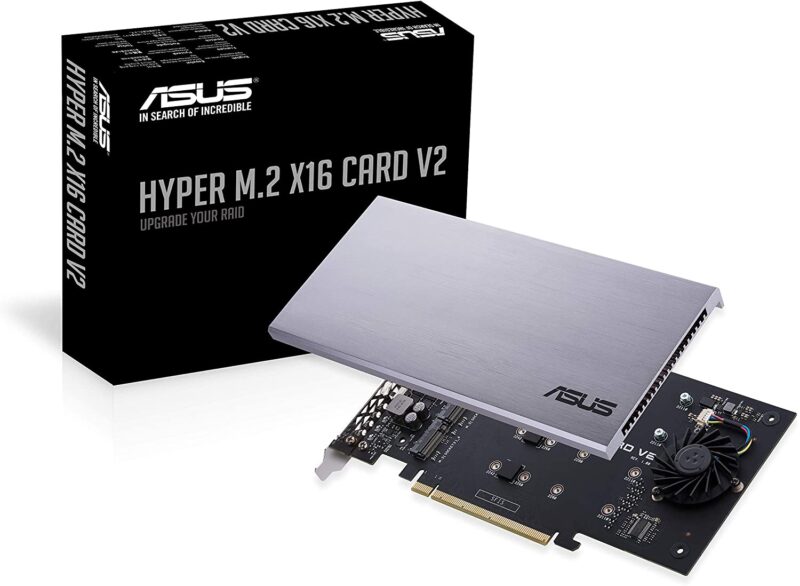
These are the most expensive and robust expansion cards, offering four M.2 slots for NVMe SSDs. They are often overkill for an average user.
As such, these cards occupy 16 PCIe lanes. Recall that each M.2 slot for NVMe SSD requires four PCIe lanes. Hence if you multiply 4 M.2 slots with 4 PCIe lanes, you get 16.
As such, the ASUS Hyper M.2 card above has an x16 connector and would require a free x16 slot on your motherboard. It will require a real x16 slot that offers the full 16 lanes. This is usually the first x16 slot on the motherboard.
The rest of the x16 slots often offer only 4 PCIe lanes; hence, this card would not be compatible with x16(x4) slots.
This card can have FOUR M.2 NVMe or M.2 SATA SSDs.

2. Single M.2 Slot for NVMe SSD with x4 Connector
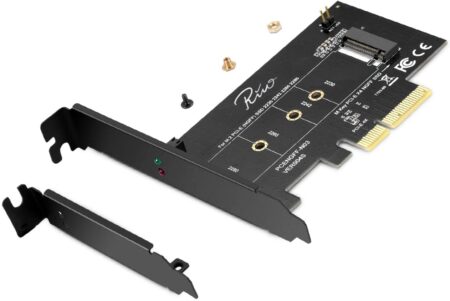
These are the most common expansion cards. These cards add a single M.2 slot to your PC and fit into an x4 slot. Hence, they have an x4 connector.
Note that there are often no real x4 slots on a given motherboard. The x4 slots on motherboards have the physical size of an x16 slot. They are hence labeled as x16(x4).
3. Single NVMe + Single SATA M.2 Slots with x4 Connector
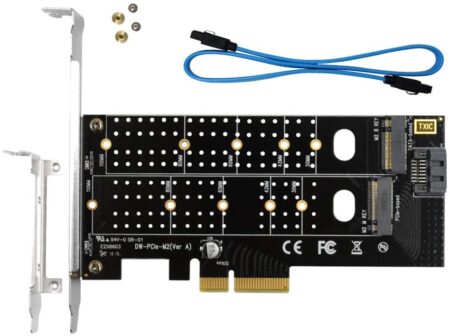
These M.2 expansion cards are also fairly common. They give you one slot for M.2 NVMe slot and one M.2 slot for SATA M.2 SSDs.
The NVMe SSD utilizes the x4 lanes, whereas, for the SATA M.2 SSD, a separate connector would plug into the SATA slot on your motherboard via the SATA cable provided.
Also Read: Can You Put M.2 SSD in PCIe Slot?
Other Types of M.2 Expansion
There is a wide variety of other types of expansion cards as well. However, as long as you understand PCIe lanes and the difference between SATA and NVMe SSDs, you should be able to procure the right card.
Make sure you have a free PCIe slot on your PC with the corresponding connector size of your expansion card, and make sure it has sufficient PCIe lanes for your M.2 expansion card.
Read in detail: What is the difference between SATA and SSD and HDD and NVMe?
The Version of the NVMe M.2 Slot Expansion Card is Very Important
It should be noted that there are different versions of the M.2 slots and the M.2 slot expansion cards.
Recall from earlier that M.2 NVMe SSDs use the PCIe interface. Now PCIe interface is an ever-evolving interface, so much so that the transfer speed per PCIe lane doubles with each newer version.
The most current version of the PCIe is 4.0.
Simply put, NVMe SSDs conforming to the newer PCIe 4.0 are almost twice as fast compared to the NVMe SSDs conforming to the older PCIe 3.0.
PCIe 4.0 NVMe SSDs are commonly called Gen 4 SSDs, whereas the PCIe 3.0 NVMe SSDs are called Gen 3 SSDs.


To use a Gen 4 SSD, you must also have a Gen 4 M.2 slot. You will need a motherboard that conforms to PCIe version 4.0.
For instance, AMD X570 motherboards have the M.2 and the PCIe slots conforming to v4.0.
To add MORE GEN 4 SSD Slots, you will need to get a GEN 4 expansion card.
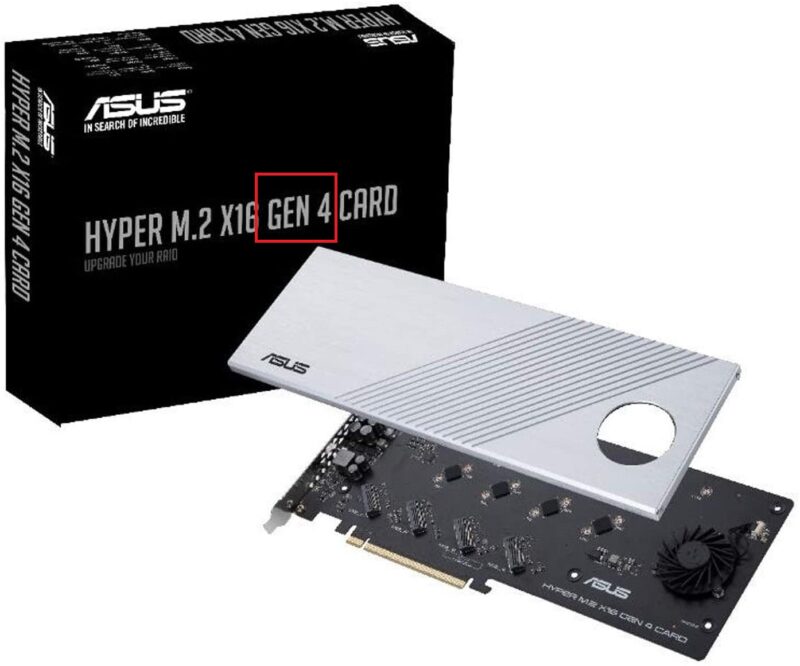
You can find Gen 4 expansion cards featuring 1-4 NVMe M.2 slots.
Also Read:
Final Words
So the simple answer to the question “how to add more M.2 SSD slots?” is to get a PCIe expansion card for M.2 slots.
However, there are many different kinds and versions of expansion cards. To choose the right one, you must understand PCIe slots, their sizes, PCIe lanes, and the difference between NVMe and SATA SSDs.
FREQUENTLY ASKED QUESTIONS
1. Can I Add a 2 M.2 SSD Slot To Your PC?
You most certainly can. You must build two M.2 slots into the motherboard or invest in an M.2 slot expansion card.
2. How Many M.2 Drives Can I Have?
The number of M.2 drives you can have depends on the number of M.2 slots on your motherboard and how many expansion cards you can install.
For instance, if you have two M.2 slots built-in and two PCIe slots with 4 lanes x16(x4) slots, you can add two more M.2 slots to your PC since each M.2 slot for NVMe SSD occupies four lanes.
3. What are some common methods for adding more M.2 SSD slots?
One common method for adding more M.2 SSD slots to a system is by using a PCIe M.2 expansion card.
These cards can be inserted into an available PCIe slot on your motherboard, and they typically come with one or more M.2 slots that can be used to install additional SSDs.
Some expansion cards also offer additional features, such as RAID support or a heatsink to help keep the SSDs cool.
4. Will adding more M.2 SSD slots affect the performance of my system in any way?
Adding more M.2 SSD slots to your system should not have a significant impact on performance, as long as your motherboard and power supply can support the additional drives.
However, it’s important to ensure that your system is properly cooled, as SSDs can generate heat during operation. Installing additional M.2 SSDs may also require you to reconfigure your storage setup, so be sure to back up any important data before making any changes to your system.
